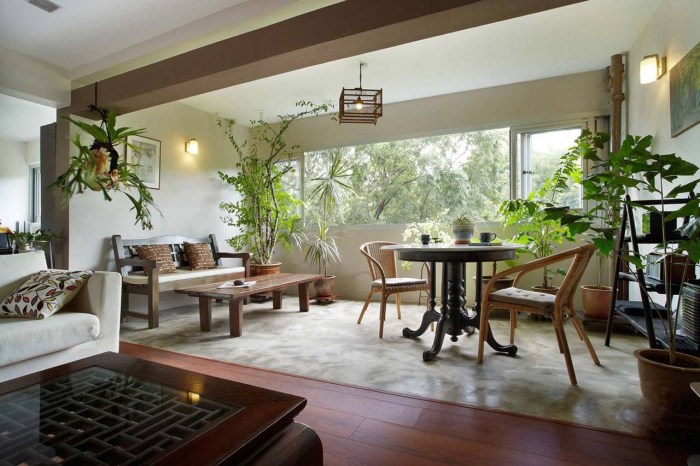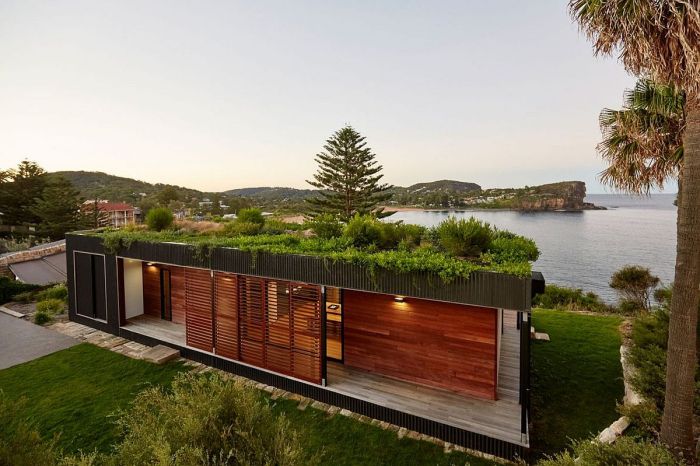Embark on a journey towards sustainable living with our comprehensive guide to Sustainable Home Design: Eco-Friendly Ideas for Every Room. Discover innovative ways to transform your abode into an eco-conscious haven, fostering a harmonious balance between style and environmental responsibility.
From incorporating sustainable materials to implementing energy-efficient practices, this guide will equip you with a wealth of practical tips and inspiring ideas to create a home that not only looks good but also does good for the planet.
Sustainable Materials

Sustainable materials are those that are sourced and produced in a way that minimizes environmental impact. They are often made from recycled or renewable resources, and they are designed to be durable and long-lasting. Using sustainable materials in home design can help to reduce the environmental footprint of your home and create a healthier living environment for your family.There
are many different types of sustainable materials that can be used in home design. Some of the most popular options include:
Bamboo
Bamboo is a fast-growing and renewable resource that can be used to make a variety of products, including flooring, furniture, and countertops. Bamboo is strong and durable, and it has a natural resistance to pests and moisture.
Recycled wood
Recycled wood is wood that has been reclaimed from old buildings or other sources. It is a great way to reduce waste and conserve resources. Recycled wood can be used for a variety of purposes, including flooring, paneling, and cabinetry.
Low-VOC paints
Low-VOC paints are paints that have a low level of volatile organic compounds (VOCs). VOCs are chemicals that can be harmful to human health and the environment. Low-VOC paints are a good choice for people who are concerned about indoor air quality.Using
sustainable materials in home design can have a positive impact on the environment. Sustainable materials can help to reduce greenhouse gas emissions, conserve water and energy, and reduce waste. They can also create a healthier living environment for your family.
Benefits of Using Sustainable Materials
There are many benefits to using sustainable materials in home design. Some of the most notable benefits include:
Reduced environmental impact
Sustainable materials are sourced and produced in a way that minimizes environmental impact. They are often made from recycled or renewable resources, and they are designed to be durable and long-lasting. Using sustainable materials in home design can help to reduce the environmental footprint of your home and create a healthier living environment for your family.
Improved indoor air quality
Sustainable materials can help to improve indoor air quality by reducing the emission of harmful chemicals. Low-VOC paints, for example, are a good choice for people who are concerned about indoor air quality.
Increased durability
Sustainable materials are often more durable than traditional materials. This is because they are often made from high-quality materials and are designed to withstand wear and tear. Sustainable materials can help to extend the life of your home and save you money on repairs and replacements.
Aesthetic appeal
Sustainable materials can be just as beautiful and stylish as traditional materials. In fact, many people find that sustainable materials add a unique and charming touch to their homes.
Examples of Sustainable Materials in Home Design
There are many different ways to use sustainable materials in home design. Some of the most popular examples include:
Bamboo flooring
Bamboo flooring is a great way to add a sustainable and stylish touch to your home. Bamboo is a fast-growing and renewable resource, and it is strong and durable. Bamboo flooring is also easy to clean and maintain.
Recycled wood countertops
Recycled wood countertops are a great way to add a unique and charming touch to your kitchen or bathroom. Recycled wood countertops are made from wood that has been reclaimed from old buildings or other sources. They are a great way to reduce waste and conserve resources.
Low-VOC paints
Low-VOC paints are a good choice for people who are concerned about indoor air quality. Low-VOC paints have a low level of volatile organic compounds (VOCs), which are chemicals that can be harmful to human health and the environment.Using sustainable materials in home design is a great way to reduce your environmental impact and create a healthier living environment for your family.
There are many different types of sustainable materials available, so you can find the perfect materials to fit your needs and style.
Energy Efficiency

Energy efficiency is a crucial aspect of sustainable home design, focusing on reducing energy consumption and minimizing the environmental impact. Implementing energy-saving techniques can significantly improve a home’s sustainability while also offering substantial cost savings.
Effective insulation plays a vital role in energy efficiency. Proper insulation helps maintain a comfortable indoor temperature, reducing the need for excessive heating or cooling. Energy-efficient appliances, such as Energy Star-rated models, consume less energy compared to traditional appliances, leading to lower energy bills.
Natural Lighting
Natural lighting is a cost-effective way to reduce energy consumption. Maximizing the use of natural light through windows and skylights can reduce the reliance on artificial lighting, especially during daytime hours.
Renewable Energy Sources
Renewable energy sources, such as solar panels and geothermal systems, can provide clean and sustainable energy for homes. Solar panels harness sunlight to generate electricity, reducing dependence on fossil fuels. Geothermal systems utilize the Earth’s natural heat to provide heating and cooling, resulting in significant energy savings.
Cost-Saving Advantages
Energy-efficient home design offers numerous cost-saving advantages. Lower energy consumption translates to reduced energy bills, saving homeowners money in the long run. Additionally, energy-efficient homes often qualify for tax incentives and rebates, further offsetting the initial investment.
Water Conservation
Water conservation is crucial for sustainable home design. Implementing water-saving fixtures and systems can significantly reduce household water consumption.
Water-Saving Fixtures
Low-flow toilets and faucets are designed to use less water per flush or cycle. Toilets with dual-flush systems offer two flushing options: a full flush for solid waste and a half flush for liquid waste. Low-flow faucets incorporate aerators or restrictors that reduce the flow rate without compromising performance.
Rainwater Harvesting
Rainwater harvesting systems collect and store rainwater from rooftops for non-potable uses, such as irrigation, toilet flushing, or laundry. By diverting rainwater from stormwater drains, these systems reduce runoff and replenish groundwater.
Greywater Systems
Greywater systems recycle wastewater from sinks, showers, and bathtubs for irrigation or other non-potable purposes. This reduces the demand for freshwater and conserves water resources.
Drought-Tolerant Landscaping, Sustainable Home Design: Eco-Friendly Ideas for Every Room
Landscaping with drought-tolerant plants minimizes water consumption. Native plants adapted to local climate conditions require less watering and maintenance. Xeriscaping, a type of landscaping that uses drought-tolerant plants and water-efficient irrigation methods, is an excellent way to conserve water in arid regions.
Indoor Air Quality
Maintaining good indoor air quality is crucial for our health and well-being. Poor air quality can lead to a range of health problems, including respiratory issues, allergies, and even chronic diseases.Natural ventilation, air purifiers, and non-toxic building materials play a vital role in improving indoor air quality.
Natural ventilation allows fresh air to circulate, diluting pollutants. Air purifiers remove harmful particles and gases from the air, while non-toxic building materials reduce the release of harmful chemicals.
Plants for Air Purification
Plants are not only beautiful additions to our homes, but they can also help purify the air. Certain plants, such as snake plants, spider plants, and peace lilies, have been shown to remove toxins from the air, including formaldehyde, benzene, and trichloroethylene.
Waste Reduction
Sustainable waste management is a crucial aspect of home design that aims to minimize waste production and promote resource conservation. By implementing strategies like composting, recycling, and using reusable products, we can significantly reduce our environmental impact.
Designing homes with designated areas for waste sorting and recycling facilitates waste management and encourages responsible disposal practices. This includes providing separate bins for compostable materials, recyclables, and general waste, making it easier for occupants to contribute to waste reduction efforts.
Composting
Composting involves the decomposition of organic materials, such as food scraps and yard waste, into a nutrient-rich soil amendment. By composting at home, we can reduce the amount of waste sent to landfills and create a valuable resource for our gardens and plants.
Recycling
Recycling involves the collection and processing of recyclable materials, such as paper, plastic, glass, and metal, to produce new products. By recycling, we conserve natural resources, reduce energy consumption, and minimize landfill waste.
Reusable Products
Using reusable products, such as water bottles, shopping bags, and containers, helps reduce single-use waste and promotes sustainability. By choosing reusable alternatives over disposable items, we can significantly reduce our environmental footprint.
Concluding Remarks
As you embrace sustainable home design principles, you’ll not only create a more eco-friendly living space but also contribute to a greener future. Remember, every small step towards sustainability makes a significant impact, and your home can be a beacon of change.
Question Bank: Sustainable Home Design: Eco-Friendly Ideas For Every Room
What are the key benefits of using sustainable materials in home design?
Sustainable materials offer numerous advantages, including reduced environmental impact, improved indoor air quality, and enhanced durability.
How can I make my home more energy-efficient?
Incorporate insulation, energy-efficient appliances, and natural lighting to reduce energy consumption. Consider renewable energy sources like solar panels and geothermal systems for sustainable power.
What are some simple ways to conserve water in my home?
Install low-flow fixtures, implement rainwater harvesting, and choose drought-tolerant plants for landscaping to minimize water usage.
